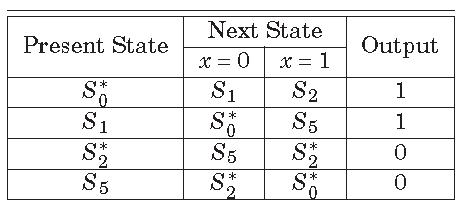State Partition Method for State Minimization is also powerful as the Implication Chart Method and better than Row Equivalence method. In this technique, the states are partitioned into groups based on the possibility that they can be combined. Lets consider the example state table as shown in Table 1 for state minimization using state partition method. This method also perform state minimization after some passes. These passes are described below.

Start :- In the first pass there is only one group and this is ![]() .
.
First Pass :- In the first pass, the states which have different outputs are partitioned in separate groups. Here, ![]() ,
, ![]() and
and ![]() have same output and thus grouped in
have same output and thus grouped in ![]() . The rest of the states have same output and thus they grouped as
. The rest of the states have same output and thus they grouped as ![]() .
.
Second Pass :- In this pass, the states are partitioned based upon their ![]() -successors. In order to combine two states, their
-successors. In order to combine two states, their ![]() -successors should be in the same partition or group.
-successors should be in the same partition or group.
Consider the first partition ![]() and their
and their ![]() -successors are
-successors are
 -successors –
-successors –  ,
,  and
and  . Here,
. Here,  and
and  belong to the same group
belong to the same group  . States
. States  ,
,  and
and  can be combined.
can be combined. -successors –
-successors –  ,
,  and
and  . Here,
. Here,  ,
,  and
and  belong to the same group
belong to the same group  . States
. States  ,
,  and
and  can be combined.
can be combined.
Now consider the second partition ![]() and their
and their ![]() -successors are
-successors are
 -successors –
-successors –  ,
,  ,
,  and
and  . Here,
. Here,  and
and  belong to the same group
belong to the same group  . States
. States  ,
,  ,
,  and
and  can be combined.
can be combined. -successors –
-successors –  ,
,  ,
,  and
and  . Here,
. Here,  ,
,  and
and  belong to group
belong to group  but
but  belong to the group
belong to the group  . Thus states
. Thus states  ,
,  and
and  can be combined but
can be combined but  is a different state and it is assigned to another partition
is a different state and it is assigned to another partition  .
.
Third Pass :- In the third pass we have three partitions ![]() ,
, ![]() and
and ![]() . Same steps are followed in this pass also.
. Same steps are followed in this pass also.
Consider the partition ![]() and their
and their ![]() -successors are
-successors are
 -successors – The
-successors – The  -successors are
-successors are  and
and  which belong to same group.
which belong to same group.  -successors – The
-successors – The  -successors are
-successors are  ,
,  and
and  . Here,
. Here,  and
and  belong to
belong to  but
but  belong to
belong to  . Thus
. Thus  can not be combined with
can not be combined with  and
and  . The state
. The state  is must be kept in another partition.
is must be kept in another partition.
Similar analysis can be run for partition ![]() and
and ![]() .
.
After the third pass, the partitions are updated as ![]() ,
, ![]() ,
, ![]() and
and ![]() . Further passes can be run but after the third pass there is no change in the partitions. Thus final states are same as result of the third pass. The state minimization result is same as the Implication chart produces as shown in Table 2.
. Further passes can be run but after the third pass there is no change in the partitions. Thus final states are same as result of the third pass. The state minimization result is same as the Implication chart produces as shown in Table 2.

